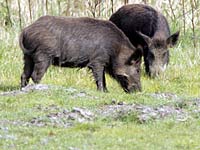Safety and Survival >> Top Wild Animals >> Wild Pigs
Safety and Survival >> Top Wild Animals >> Wild Pigs

How to Survive if Threatened:

 Feral pigs are considered an exotic and invasive species. They cause extensive damage to agricultural lands and other environments. The rooting feeding behavior of pigs destroys native plant species which disrupts natural plant communities. These disturbances can allow exotic plant species to become established which further negatively impacts the native plant communities. This rooting also creates areas of erosion, especially near stream banks, which in turn can impact the water quality making life harder for aquatic wildlife. Pigs living in the wild compete with the native wildlife for food, water, cover and space. Deer, bears, turkeys, foxes, bobcats, and raccoons are just a few examples of animals that compete with wild hogs for resources.
Feral pigs are considered an exotic and invasive species. They cause extensive damage to agricultural lands and other environments. The rooting feeding behavior of pigs destroys native plant species which disrupts natural plant communities. These disturbances can allow exotic plant species to become established which further negatively impacts the native plant communities. This rooting also creates areas of erosion, especially near stream banks, which in turn can impact the water quality making life harder for aquatic wildlife. Pigs living in the wild compete with the native wildlife for food, water, cover and space. Deer, bears, turkeys, foxes, bobcats, and raccoons are just a few examples of animals that compete with wild hogs for resources.Pigs can adapt to wide range of habitats, have a high reproductive rate (two litters of 4-14 piglets a year), and have few natural predators which makes them hard to control. Known predators of wild pigs include black bears, mountain lion, bobcats, coyotes, and owls, all of which are unable to keep pig populations in check.
 In many states the departments of Natural Resources, Wildlife, etc are asking people to report any sightings of wild pigs. These sightings are used to track their numbers and to assist in control methods. Some states allow people with a concealed pistol permit (CPL) or valid hunting license to take any opportunity to kill any free-ranging pig running at large on public property.
In many states the departments of Natural Resources, Wildlife, etc are asking people to report any sightings of wild pigs. These sightings are used to track their numbers and to assist in control methods. Some states allow people with a concealed pistol permit (CPL) or valid hunting license to take any opportunity to kill any free-ranging pig running at large on public property.
Maybe you didn't see an actual pig but instead saw where it has been. Pigs leave evidence from rooting, wallows and rubbings as well as from tracks and from creating trails. The tracks of wild pigs are close to those of deer except they have rounded toes. They generally appear more rounded than the tracks of deer as well as being wider than they are long, plus they are shorter than deer tracks of the same width.
Wild pigs are definitely an unfortunate threat to our natural environment and they are just one more potential danger that a hiker can encounter on the trail.
Like it? Share & bookmark this page!
